Ijraset Journal For Research in Applied Science and Engineering Technology
- Home / Ijraset
- On This Page
- Abstract
- Introduction
- Conclusion
- References
- Copyright
Enhancing Optimal Thermal Energy Storage in Solar Parabolic Concentrator System by Using Phase Change Material
Authors: Om Prakash Kumar, Amit Shrivastava
DOI Link: https://doi.org/10.22214/ijraset.2023.56040
Certificate: View Certificate
Abstract
Solar Parabolic Trough Systems (PTS) are highly efficient solar thermal technologies for converting concentrated solar radiation into thermal energy. However, their intermittent energy production, primarily due to variations in solar availability, underscores the necessity for effective thermal energy storage (TES) solutions. Phase Change Materials (PCMs) have emerged as a promising means to store and release thermal energy efficiently. This study focuses on the critical task of optimizing PCM properties to enhance thermal energy storage within Solar Parabolic Trough Systems. The selection and fine-tuning of PCM properties are paramount to achieving superior TES performance. Parameters under scrutiny include the melting temperature, latent heat of fusion, thermal conductivity, and cost-effectiveness. Each of these factors plays a pivotal role in the overall efficiency and economic viability of PCM-based TES systems integrated with PTS. Through a thorough review of existing research and recent advancements in the field, this study sheds light on the profound impact of tailored PCM properties. It demonstrates how optimizing these properties can lead to substantial improvements in energy storage capacity, system efficiency, and overall cost-effectiveness. Such optimizations are crucial not only for enhancing the competitiveness of solar thermal technology but also for promoting sustainable energy utilization. The investigation presented herein underscores the significance of PCM property optimization as a strategic pathway toward advancing solar thermal technology. By maximizing energy storage capacity, minimizing thermal losses, and optimizing cost factors, we can unlock the full potential of PTS, making them more reliable and accessible for meeting the world\'s growing energy demands. This research serves as a valuable resource for engineers, researchers, and stakeholders working towards the integration of PCM-based TES with solar thermal systems. Ultimately, it contributes to the realization of a cleaner, more sustainable energy future, addressing the urgent need to reduce greenhouse gas emissions and our reliance on non-renewable energy sources.
Introduction
I. INTRODUCTION
The global demand for energy continues to rise, driven by population growth, industrialization, and increasing living standards. In this context, sustainable and renewable energy sources are becoming crucial to mitigate the environmental impacts of conventional fossil fuel-based energy systems. Solar energy, abundant and clean, stands out as a viable solution to meet a significant portion of this growing energy demand. Solar thermal energy, in particular, offers an effective means to harness the sun's power and convert it into usable thermal energy.
One of the key challenges in utilizing solar thermal energy is its intermittent nature due to the variability in solar irradiance. To address this issue and enhance the efficiency and effectiveness of solar thermal systems, integrating solar collectors with thermal energy storage systems is essential. Phase Change Material (PCM) based thermal energy storage is a promising technology that allows the efficient storage and retrieval of thermal energy, providing a continuous and reliable source of heat even during periods of low solar radiation.
This paper explores the integration of a solar parabolic trough collector with a Phase Change Material (PCM) based thermal energy storage system. The parabolic trough collector is a well-established solar thermal technology known for its high efficiency in concentrating solar radiation and converting it into thermal energy. On the other hand, PCM technology offers an efficient means of storing and utilizing thermal energy through phase transitions.
The integration of a PCM-based thermal energy storage system with a solar parabolic trough collector aims to maximize the utilization of solar energy by capturing excess thermal energy during peak solar hours and storing it in PCM. This stored energy can then be utilized during non-solar hours or cloudy periods, ensuring a consistent and reliable energy supply. Additionally, this integration improves the overall efficiency of the solar thermal system and contributes to the reduction of greenhouse gas emissions and reliance on non-renewable energy sources.
A. Solar Thermal Collectors
Solar thermal collectors are devices that utilize sunlight to generate thermal energy for various applications, primarily space heating, water heating, and electricity generation. They are a vital component of solar thermal systems, harnessing solar radiation and converting it into usable heat. There are several types of solar thermal collectors, including flat-plate collectors, evacuated tube collectors, parabolic troughs, and dish collectors.
Flat-plate collectors are the most common and comprise an insulated, weatherproof box with a dark absorber plate that absorbs sunlight, heating a fluid or air passing through it. Evacuated tube collectors consist of a series of glass tubes containing an absorber, maintaining high efficiency even in cold climates. Parabolic troughs use curved, mirrored reflectors to concentrate sunlight onto a receiver tube, heating a fluid inside. Dish collectors focus sunlight onto a small area, typically containing a Stirling engine or a photovoltaic cell to generate electricity.
Solar thermal collectors are essential for renewable energy production, promoting sustainability and reducing greenhouse gas emissions. Ongoing research and development aim to enhance their efficiency, cost-effectiveness, and integration into various applications.
B. Classification of Solar Thermal Collectors
Solar thermal collectors can be classified based on various criteria, including their design, the way they capture and utilize solar energy, and their specific applications. Here's a classification based on design and application:
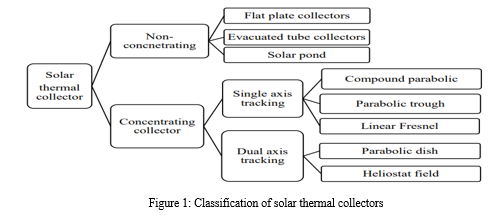
C. Based on Design
- Flat-Plate Collectors: Flat-plate collectors are the most common type and consist of a flat absorber plate with a transparent cover and insulation. - The absorber plate absorbs solar energy and transfers it to a fluid (air, water, or another heat transfer fluid) for heating purposes.
- Evacuated Tube Collectors: Evacuated tube collectors use rows of transparent glass tubes with an absorber tube inside each. - The vacuum between the tubes reduces heat loss and enhances thermal efficiency. - They are more efficient in capturing solar energy compared to flat-plate collectors.
- Parabolic Trough Collectors: Parabolic trough collectors use parabolic-shaped mirrors to focus sunlight onto a receiver tube placed at the focal line of the parabola. - The receiver tube contains a heat transfer fluid (often oil) that is heated by concentrated sunlight. - Commonly used in large-scale solar power plants to generate electricity.
- Fresnel Reflectors: Fresnel reflectors use a series of flat, narrow mirrors (Fresnel lenses) to concentrate sunlight onto a linear receiver. - They are often used in concentrated solar power (CSP) systems for electricity generation.
D. Based on Application
- Domestic Water Heating: Solar collectors designed to provide hot water for residential or small-scale commercial purposes. - Usually flat-plate or evacuated tube collectors are used.
- Space Heating: Solar collectors used to provide heat for space heating in buildings. - Flat-plate collectors are commonly used for this purpose.
- Industrial Process Heat: Solar thermal systems designed to provide high-temperature heat for industrial processes. - Often use concentrating collectors like parabolic troughs or Fresnel reflectors.
- Solar Cooling: Solar collectors used in combination with absorption chillers to provide solar-powered air conditioning or refrigeration. - Absorption chillers are typically powered by high-temperature heat from solar collectors.
- Electricity Generation (Concentrated Solar Power - CSP): Solar collectors designed to generate electricity by concentrating sunlight to produce high temperatures and drive turbines. - Parabolic troughs, Fresnel reflectors, and other concentrating collectors are used.
II. MATERIALS
- Choose a suitable PCM based on desired phase change temperature matching solar parabolic trough operating temperatures. E.g., paraffin waxes, salt hydrates, or eutectic mixtures.
- Add thermally conductive materials (e.g., graphite, carbon nanotubes) to enhance the thermal conductivity of the PCM, improving heat transfer rates during charging and discharging.
- Utilize nanostructured materials to enhance surface area and promote nucleation, aiding in achieving desired phase change temperatures and improving heat transfer efficiency.
- Develop composites by combining PCMs with suitable matrices to improve structural stability, mechanical properties, and thermal conductivity.
III. METHODOLOGY
- Conduct a thorough analysis to determine the phase transition temperature, heat of fusion, thermal conductivity, and specific heat capacity of selected PCMs.
- Employ techniques like sol-gel, mechanical mixing, or in-situ polymerization to introduce nanomaterials or form composites with the PCM. b. Characterize the nanostructured PCM and composite materials to assess changes in properties.
- Mix PCMs with conductive materials and analyze the thermal conductivity using appropriate methods (e.g., transient plane source technique). b. Optimize the ratio of conductive materials to achieve enhanced thermal conductivity.
- Subject the PCMs and composites to multiple thermal cycles to assess stability, phase change temperatures, and energy storage/release capabilities. b. Evaluate any degradation or hysteresis effects over extended cycles.
- Design and simulate the integration of optimized PCMs within the solar parabolic trough system using software like TRNSYS or SAM. b. Evaluate system performance under varying solar conditions and thermal storage requirements.
- Conduct a detailed cost analysis considering the cost of materials, encapsulation, and potential efficiency gains to determine the cost-effectiveness of the optimized PCM.
- Perform an environmental impact assessment to analyze the sustainability and eco-friendliness of using the optimized PCM materials.
- Validate the optimized PCM properties in a real-world solar parabolic trough setup, analyzing performance under actual solar radiation and thermal load conditions.
A. Solar Parabolic Dish Collector
A solar parabolic dish collector, also known as a parabolic dish concentrator, is a type of solar thermal technology used to concentrate sunlight onto a small focal point to produce heat or generate electricity. The collector is designed in a parabolic shape to focus sunlight onto a receiver at the focal point.

Here are key components and aspects of a solar parabolic dish collector:
- Parabolic Dish Structure
- The collector is shaped like a parabolic dish, resembling a large satellite dish, with a highly reflective surface to concentrate sunlight.
- The parabolic shape helps to focus sunlight from all directions onto a single point, the focal point.
- Reflective Surface
- The inner surface of the parabolic dish is covered with highly reflective material, such as polished aluminum or special reflective coatings, to efficiently reflect and concentrate sunlight.
- Receiver at Focal Point
- At the focal point of the parabolic dish, there is a receiver where the concentrated sunlight is directed.
- The receiver can be a thermal absorber, a Stirling engine, a Brayton cycle engine, or a photovoltaic (PV) cell, depending on the application.
- Thermal Absorber
- In many solar parabolic dish systems, a thermal absorber is used to capture the concentrated sunlight and convert it into thermal energy.
- The absorber is often a pipe or receiver containing a heat transfer fluid (e.g., oil or water) that absorbs the concentrated solar heat and transfers it for further use, like electricity generation or heating.
- Tracking System
- To ensure the parabolic dish is always oriented towards the sun and maximizes solar concentration, a tracking system is employed.
- The tracking system adjusts the orientation of the parabolic dish to follow the sun's movement throughout the day.
- Applications
- Solar parabolic dish collectors can be used for various applications, including electricity generation, water heating, space heating, industrial process heat, and even for solar cooking.
- Electricity Generation
- In electricity generation, the concentrated sunlight at the receiver is used to power a heat engine (e.g., Stirling engine or Brayton cycle engine) that drives a generator to produce electricity.
- Efficiency and Concentration Ratio
- Parabolic dish collectors can achieve very high concentration ratios, often exceeding 1000 suns, which significantly increases the temperature at the focal point and enhances efficiency.
B. Case 1 Pcm – Neopentyl glycol , cooking material- rice + water
1) Morning PCM charging
Neopentyl glycol, a phase transition substance, was filled in the outside part of the concentric cylinder type solar cooker in the experiment's initial phase. To charge the PCM at 9:00 am, a solar cooker is placed on the plate of a parabolic dish collector and exposed to solar light. At 10:20 am, the ambient temperature rose from 25°C to 28.1°C. PCM temperature began to rise at 25°C and quickly increased to 84.1°C. Similar to this, the temperature of the pot's bottom climbs from 25°C to 149°C. Morning solar radiation levels vary from 402 W/m2 to 545 W/m2.

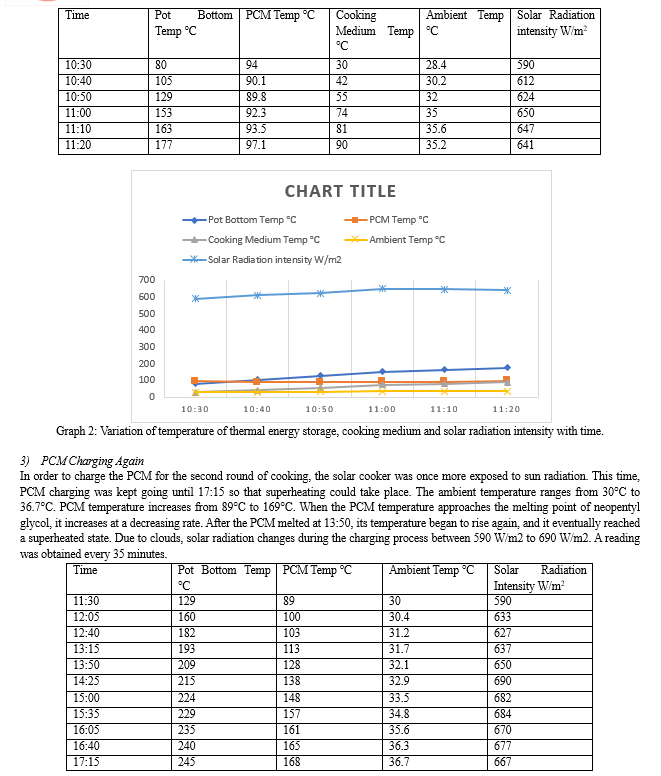
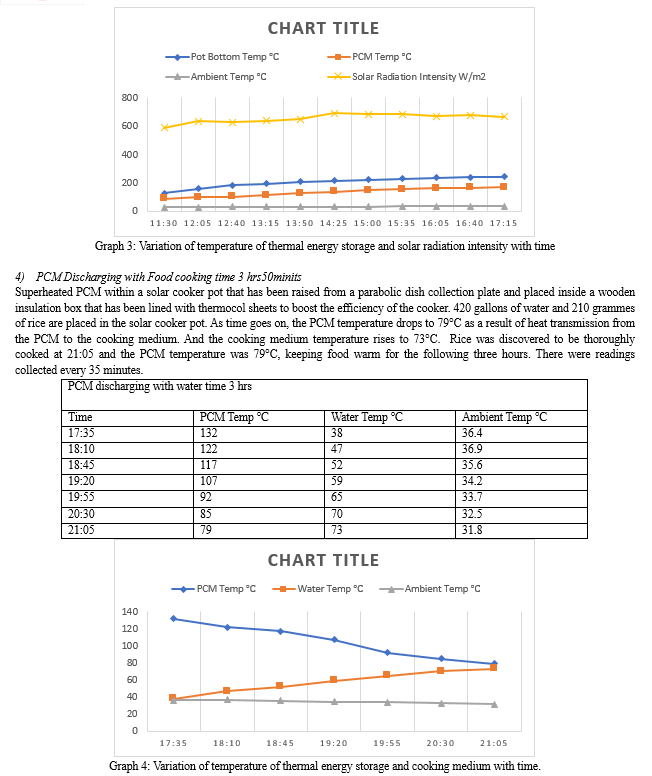
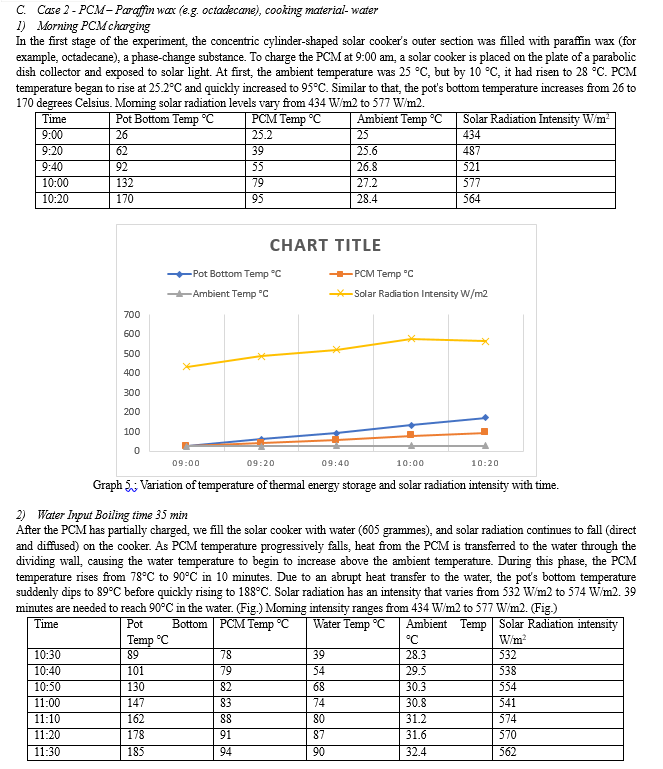

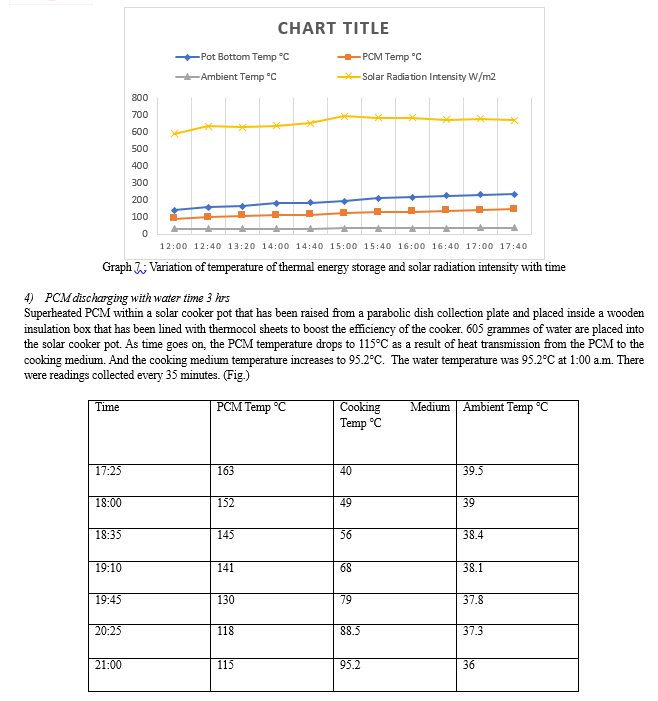
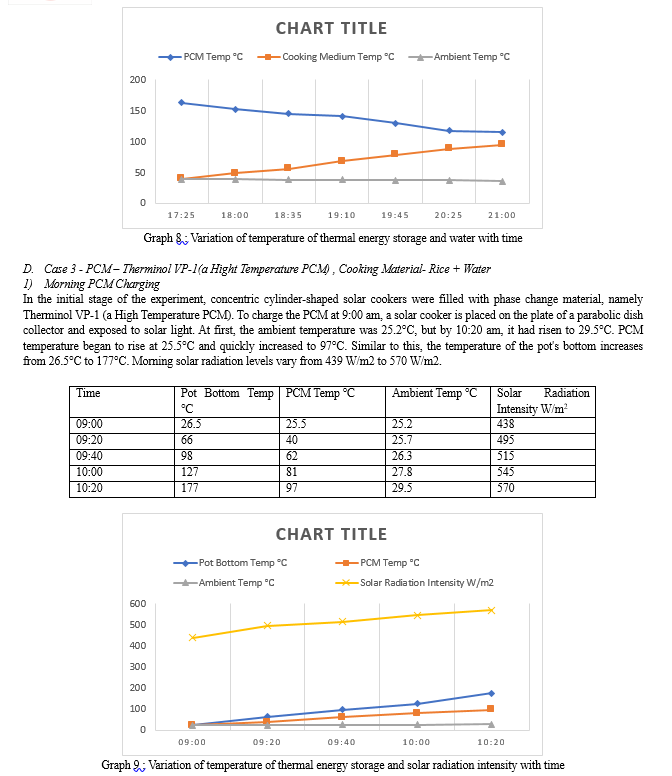



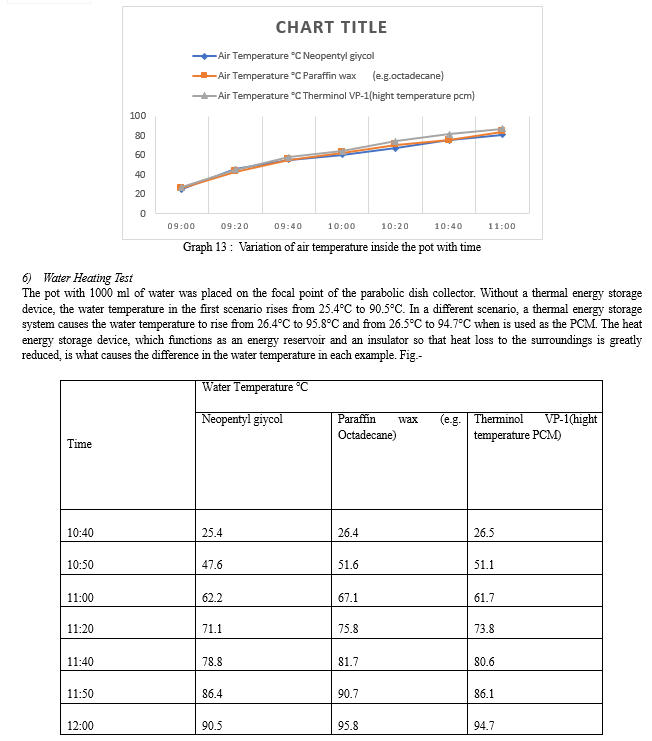
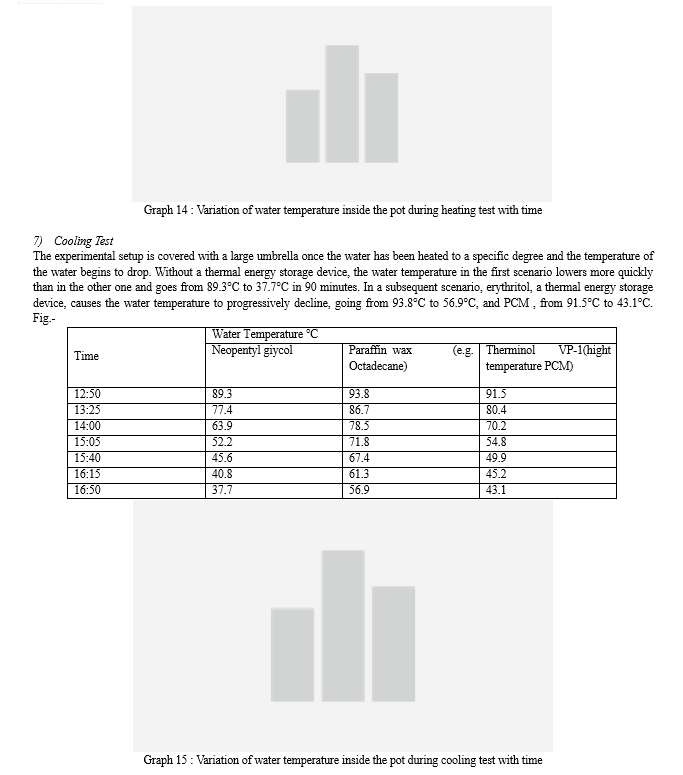
IV. FUTURE SCOPE
- This study sets the stage for future research in various directions. Further investigation into a wider range of PCMs, including novel PCM composites, would enhance the understanding of their suitability for water heating applications. Exploring advanced encapsulation techniques and integration of PCMs into water heating systems for real-world applications are crucial steps. Additionally, assessing the long-term stability and cyclic performance of PCMs is essential for sustainable and reliable utilization. The findings from this study can guide the development of efficient PCM-based water heating systems, contributing to energy conservation and sustainable heating solutions.
- This study sets the stage for future research in various directions. Further investigation into a wider range of PCMs, including novel PCM composites, would enhance the understanding of their suitability for water heating applications. Exploring advanced encapsulation techniques and integration of PCMs into water heating systems for real-world applications are crucial steps. Additionally, assessing the long-term stability and cyclic performance of PCMs is essential for sustainable and reliable utilization. The findings from this study can guide the development of efficient PCM-based water heating systems, contributing to energy conservation and sustainable heating solutions.
- This study paves the way for future research in several directions. Further investigation into a broader spectrum of PCMs and varied environmental conditions will enhance our understanding of PCM behavior during cooling processes. Exploring innovative encapsulation techniques to improve thermal conductivity and stability of PCMs is essential. Additionally, studying the impact of different cooling rates and examining the cyclic stability of PCMs for prolonged use will contribute to practical applications. Integration of PCMs into cooling systems, such as air conditioning, can also be explored for potential energy-efficient cooling solutions. Overall, the findings lay the groundwork for utilizing PCMs in cooling applications, promoting sustainable and efficient cooling technologies.
Conclusion
A. Stagnation Temperature test stagnation temperature tests conducted on Neopentyl glycol, paraffin wax (octadecane), and Therminol VP-1 (a high-temperature phase change material or PCM) within the solar collector yielded valuable insights. As the exposure duration increased, the stagnation temperatures consistently rose for all three PCMs, showcasing their capacity to store thermal energy during stagnation periods. B. Water Heating test Time The distinctive temperature behaviors emphasize the importance of selecting an appropriate PCM tailored to specific temperature requirements. Neopentyl glycol and paraffin wax are suitable for moderate-temperature applications, while Therminol VP-1 excels in high-temperature solar thermal systems. The water heating tests provided valuable insights into the thermal performance of Neopentyl glycol, paraffin wax (octadecane), and Therminol VP-1 (a high-temperature phase change material or PCM) for heating water. As the exposure duration increased, all three PCMs effectively transferred thermal energy to the water, elevating its temperature. Therminol VP-1 showcased efficient heating capabilities, raising the water temperature to 94.7°C by 12:00. Paraffin wax closely followed, achieving a temperature of 95.8°C. Neopentyl glycol exhibited slightly lower temperatures, reaching 90.5°C by 12:00. C. Cooling Test The cooling tests provided insights into the thermal performance of Neopentyl glycol, paraffin wax (octadecane), and Therminol VP-1 (a high-temperature phase change material or PCM) for cooling water. As the exposure duration increased, all three PCMs effectively absorbed thermal energy from the water, leading to a decrease in temperature. Therminol VP-1 exhibited efficient cooling capabilities, with the water temperature reaching 43.1°C by 16:50. Paraffin wax closely followed, achieving a temperature of 56.9°C. Neopentyl glycol exhibited slightly higher temperatures, reaching 37.7°C by 16:50.
References
[1] Idowu David Ibrahim Development of Smart Parabolic Trough Solar Collector for Water Heating and Hybrid Polymeric Composite Water Storage Tank HAL Id: tel-03220701https://theses.hal.science/tel-03220701Submitted on 7 May 2021 [2] Ashok Kumar Singh, Samsher “Techno-environ-economic-energy-exergy-matrices performance analysis of evacuated annulus tube with modified parabolic concentrator assisted single slope solar desalination system”Journal of Cleaner Production Volume 332, 15 January 2022, 129996 [3] Bilal Lamrani a, Frédéric Kuznik a, Abdeslam Draoui “Thermal performance of a coupled solar parabolic trough collector latent heat storage unit for solar water heating in large buildings” Renewable EnergyVolume 162, December 2020, Pages 411-426 [4] Author links open overlay panelMostafa Gharzi a, Ali M. Kermani a, Hosseinali Tash Shamsabadi “Experimental investigation of a parabolic trough collector-thermoelectric generator (PTC-TEG) hybrid solar system with a pressurized heat transfer fluid”Renewable EnergyVolume 202, January 2023, Pages 270-279 [5] a, Man Mohan b, Kishor Rambhad c, Agnivesh Kumar Sinha b “Experimental and theoretical study for suitability of hybrid nano enhanced phase change material for thermal energy storage applications” Journal of Energy Storage Volume 51, July 2022, 104431 [6] Ram Kumar Pal, K. Ravi Kumar “Investigations of thermo-hydrodynamics, structural stability, and thermal energy storage for direct steam generation in parabolic trough solar collector: A comprehensive review” Journal of Cleaner Production Volume 311, 15 August 2021, 12755 [7] Montaser Mahmoud, Keith Pullen, Mohamad Ramadan, Ahma “Phase Change Materials Integrated Into Solar Parabolic Collectors” Encyclopedia of Smart Materials Volume 2, 2022, Pages 613-620 [8] Nishith B. Desai * , Maria E. Mondejar 1 , Fredrik Haglind “Techno-economic analysis of two-tank and packed-bed rock thermal energy storages for foil-based concentrating solar collector driven cogeneration plants” Renewable Energy Volume 186, March 2022, Pages 814-830
Copyright
Copyright © 2023 Om Prakash Kumar, Amit Shrivastava . This is an open access article distributed under the Creative Commons Attribution License, which permits unrestricted use, distribution, and reproduction in any medium, provided the original work is properly cited.

Download Paper
Paper Id : IJRASET56040
Publish Date : 2023-10-07
ISSN : 2321-9653
Publisher Name : IJRASET
DOI Link : Click Here
 Submit Paper Online
Submit Paper Online

